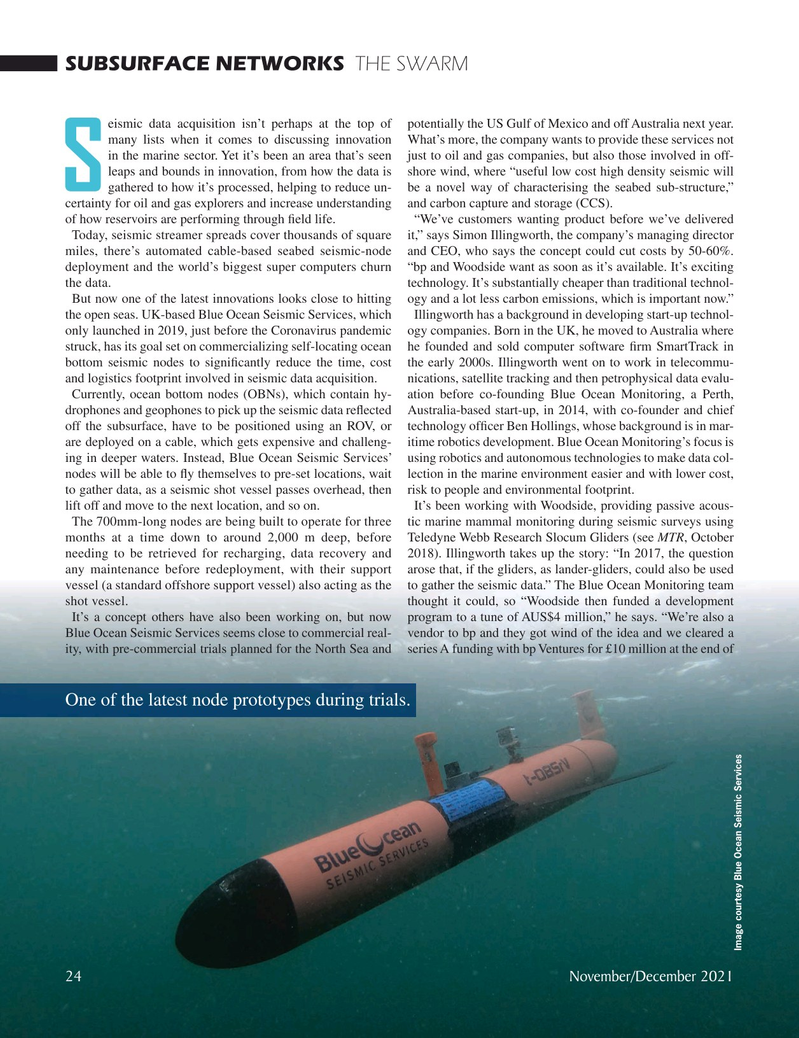
Page 24: of Marine Technology Magazine (November 2021)
Ocean Observation: Gliders, Buoys & Sub-Surface Networks
Read this page in Pdf, Flash or Html5 edition of November 2021 Marine Technology Magazine
SUBSURFACE NETWORKS THE SWARM eismic data acquisition isn’t perhaps at the top of potentially the US Gulf of Mexico and off Australia next year. many lists when it comes to discussing innovation What’s more, the company wants to provide these services not in the marine sector. Yet it’s been an area that’s seen just to oil and gas companies, but also those involved in off- leaps and bounds in innovation, from how the data is shore wind, where “useful low cost high density seismic will
S gathered to how it’s processed, helping to reduce un- be a novel way of characterising the seabed sub-structure,” certainty for oil and gas explorers and increase understanding and carbon capture and storage (CCS). of how reservoirs are performing through ? eld life. “We’ve customers wanting product before we’ve delivered
Today, seismic streamer spreads cover thousands of square it,” says Simon Illingworth, the company’s managing director miles, there’s automated cable-based seabed seismic-node and CEO, who says the concept could cut costs by 50-60%. deployment and the world’s biggest super computers churn “bp and Woodside want as soon as it’s available. It’s exciting the data. technology. It’s substantially cheaper than traditional technol-
But now one of the latest innovations looks close to hitting ogy and a lot less carbon emissions, which is important now.” the open seas. UK-based Blue Ocean Seismic Services, which Illingworth has a background in developing start-up technol- only launched in 2019, just before the Coronavirus pandemic ogy companies. Born in the UK, he moved to Australia where struck, has its goal set on commercializing self-locating ocean he founded and sold computer software ? rm SmartTrack in bottom seismic nodes to signi? cantly reduce the time, cost the early 2000s. Illingworth went on to work in telecommu- and logistics footprint involved in seismic data acquisition. nications, satellite tracking and then petrophysical data evalu-
Currently, ocean bottom nodes (OBNs), which contain hy- ation before co-founding Blue Ocean Monitoring, a Perth, drophones and geophones to pick up the seismic data re? ected Australia-based start-up, in 2014, with co-founder and chief off the subsurface, have to be positioned using an ROV, or technology of? cer Ben Hollings, whose background is in mar- are deployed on a cable, which gets expensive and challeng- itime robotics development. Blue Ocean Monitoring’s focus is ing in deeper waters. Instead, Blue Ocean Seismic Services’ using robotics and autonomous technologies to make data col- nodes will be able to ? y themselves to pre-set locations, wait lection in the marine environment easier and with lower cost, to gather data, as a seismic shot vessel passes overhead, then risk to people and environmental footprint. lift off and move to the next location, and so on. It’s been working with Woodside, providing passive acous-
The 700mm-long nodes are being built to operate for three tic marine mammal monitoring during seismic surveys using months at a time down to around 2,000 m deep, before Teledyne Webb Research Slocum Gliders (see MTR, October needing to be retrieved for recharging, data recovery and 2018). Illingworth takes up the story: “In 2017, the question any maintenance before redeployment, with their support arose that, if the gliders, as lander-gliders, could also be used vessel (a standard offshore support vessel) also acting as the to gather the seismic data.” The Blue Ocean Monitoring team shot vessel. thought it could, so “Woodside then funded a development
It’s a concept others have also been working on, but now program to a tune of AUS$4 million,” he says. “We’re also a
Blue Ocean Seismic Services seems close to commercial real- vendor to bp and they got wind of the idea and we cleared a ity, with pre-commercial trials planned for the North Sea and series A funding with bp Ventures for £10 million at the end of
One of the latest node prototypes during trials.
Image courtesy Blue Ocean Seismic Services 24 November/December 2021
MTR #8 (18-33).indd 24 11/22/2021 11:57:48 AM

 23
23

 25
25
